BIZ201 Case Study: Crystal Hotel Financial Performance Analysis
VerifiedAdded on 2023/01/16
|15
|2988
|23
Case Study
AI Summary
This case study analyzes the financial statements of Crystal Hotel Pty Ltd for the period ending June 30, 2015. It includes a vertical analysis of the profit and loss account and the statement of financial position, calculating percentages for various revenue and expense items. Key financial ratios, including profitability, efficiency, liquidity, and solvency ratios, are calculated and compared to industry benchmarks. The analysis also includes a comparative analysis of the income statement, highlighting revenue sources, cost of sales, personnel costs, and operating costs. The study evaluates Crystal Hotel's financial performance, identifying strengths and weaknesses, and provides recommendations for improvement, focusing on cost management and revenue optimization. The case study assesses the company's profitability, efficiency in managing assets and liabilities, and overall financial stability, providing a comprehensive overview of Crystal Hotel's financial health.
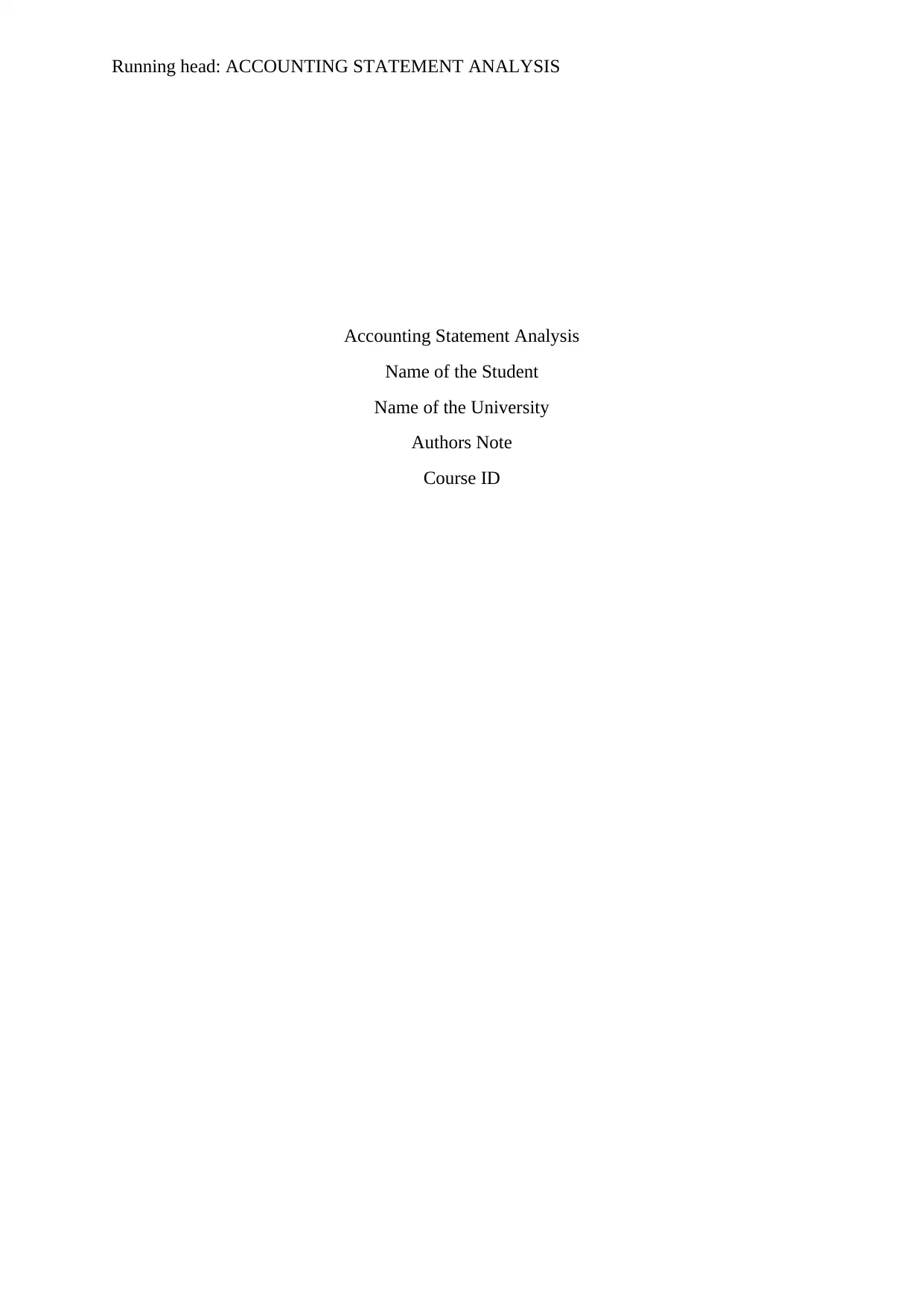
Running head: ACCOUNTING STATEMENT ANALYSIS
Accounting Statement Analysis
Name of the Student
Name of the University
Authors Note
Course ID
Accounting Statement Analysis
Name of the Student
Name of the University
Authors Note
Course ID
Paraphrase This Document
Need a fresh take? Get an instant paraphrase of this document with our AI Paraphraser

1ACCOUNTING STATEMENT ANALYSIS
Table of Contents
Part 1..........................................................................................................................................2
Vertical Analysis of Profit and Loss Account........................................................................2
Vertical Analysis of Statement of Financial Position:...........................................................4
Calculation of Key Financial Ratios:.....................................................................................6
Part 2:.........................................................................................................................................6
Analysis of information included in the general purpose financial statements:....................6
Comparative Analysis of Income Statement:.........................................................................7
Ratio Analysis:...........................................................................................................................9
Profitability Ratios:................................................................................................................9
Efficiency Ratios:...................................................................................................................9
Liquidity ratios:....................................................................................................................10
Solvency Ratios:...................................................................................................................10
Additional industry specific benchmarks:............................................................................11
References................................................................................................................................12
Table of Contents
Part 1..........................................................................................................................................2
Vertical Analysis of Profit and Loss Account........................................................................2
Vertical Analysis of Statement of Financial Position:...........................................................4
Calculation of Key Financial Ratios:.....................................................................................6
Part 2:.........................................................................................................................................6
Analysis of information included in the general purpose financial statements:....................6
Comparative Analysis of Income Statement:.........................................................................7
Ratio Analysis:...........................................................................................................................9
Profitability Ratios:................................................................................................................9
Efficiency Ratios:...................................................................................................................9
Liquidity ratios:....................................................................................................................10
Solvency Ratios:...................................................................................................................10
Additional industry specific benchmarks:............................................................................11
References................................................................................................................................12

2ACCOUNTING STATEMENT ANALYSIS
Part 1
Vertical Analysis of Profit and Loss Account
Revenue
Rooms Revenue $40,06,920 61.88%
Food and Beverage Revenue $9,36,497 14.46%
Functions $9,60,326 14.83%
Other Revenue $5,71,906 8.83%
Total Revenue $64,75,650 100%
Cost of Sales
Rooms Cost of Sales $8,44,634 13.04%
Food and Beverage Cost of Sales $8,07,461 12.47%
Other Cost of Sales $1,34,636 2.08%
Total Cost of Sales ( excluding personnel cost) $17,86,731 27.59%
Gross Profit $46,88,919 72.41%
Personnel Costs
Rooms $4,92,078 7.60%
Food and Beverage $4,58,716 7.08%
Administrative and General $2,97,868 4.60%
Sales and Marketing $2,22,209 3.43%
Property Management and Maintenance $1,72,763 2.67%
Total Personnel Costs $16,43,634 25.38%
Crystal Hotel Pty Ltd
Statement of Profit or Loss
For the period ended 30/ 06/ 2015
Vertical
Analysis
Part 1
Vertical Analysis of Profit and Loss Account
Revenue
Rooms Revenue $40,06,920 61.88%
Food and Beverage Revenue $9,36,497 14.46%
Functions $9,60,326 14.83%
Other Revenue $5,71,906 8.83%
Total Revenue $64,75,650 100%
Cost of Sales
Rooms Cost of Sales $8,44,634 13.04%
Food and Beverage Cost of Sales $8,07,461 12.47%
Other Cost of Sales $1,34,636 2.08%
Total Cost of Sales ( excluding personnel cost) $17,86,731 27.59%
Gross Profit $46,88,919 72.41%
Personnel Costs
Rooms $4,92,078 7.60%
Food and Beverage $4,58,716 7.08%
Administrative and General $2,97,868 4.60%
Sales and Marketing $2,22,209 3.43%
Property Management and Maintenance $1,72,763 2.67%
Total Personnel Costs $16,43,634 25.38%
Crystal Hotel Pty Ltd
Statement of Profit or Loss
For the period ended 30/ 06/ 2015
Vertical
Analysis
⊘ This is a preview!⊘
Do you want full access?
Subscribe today to unlock all pages.

Trusted by 1+ million students worldwide
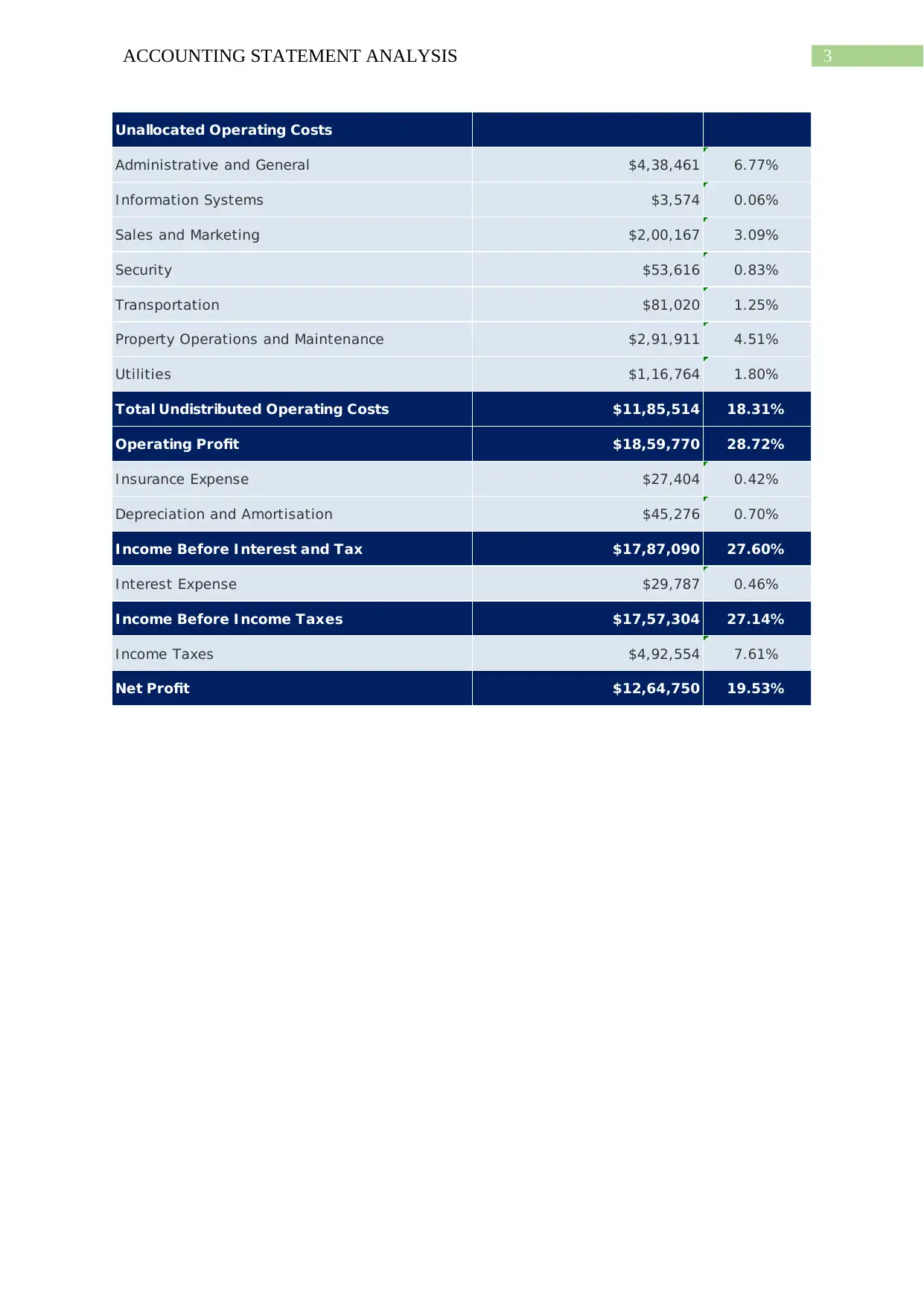
3ACCOUNTING STATEMENT ANALYSIS
Unallocated Operating Costs
Administrative and General $4,38,461 6.77%
I nformation Systems $3,574 0.06%
Sales and Marketing $2,00,167 3.09%
Security $53,616 0.83%
Transportation $81,020 1.25%
Property Operations and Maintenance $2,91,911 4.51%
Utilities $1,16,764 1.80%
Total Undistributed Operating Costs $11,85,514 18.31%
Operating Profit $18,59,770 28.72%
I nsurance Expense $27,404 0.42%
Depreciation and Amortisation $45,276 0.70%
I ncome Before I nterest and Tax $17,87,090 27.60%
I nterest Expense $29,787 0.46%
I ncome Before I ncome Taxes $17,57,304 27.14%
I ncome Taxes $4,92,554 7.61%
Net Profit $12,64,750 19.53%
Unallocated Operating Costs
Administrative and General $4,38,461 6.77%
I nformation Systems $3,574 0.06%
Sales and Marketing $2,00,167 3.09%
Security $53,616 0.83%
Transportation $81,020 1.25%
Property Operations and Maintenance $2,91,911 4.51%
Utilities $1,16,764 1.80%
Total Undistributed Operating Costs $11,85,514 18.31%
Operating Profit $18,59,770 28.72%
I nsurance Expense $27,404 0.42%
Depreciation and Amortisation $45,276 0.70%
I ncome Before I nterest and Tax $17,87,090 27.60%
I nterest Expense $29,787 0.46%
I ncome Before I ncome Taxes $17,57,304 27.14%
I ncome Taxes $4,92,554 7.61%
Net Profit $12,64,750 19.53%
Paraphrase This Document
Need a fresh take? Get an instant paraphrase of this document with our AI Paraphraser

4ACCOUNTING STATEMENT ANALYSIS
Vertical Analysis of Statement of Financial Position:
Current Assets
Cash and Cash Equivalents $7,10,535 12.76%
Accounts Receivable $6,99,930 12.57%
I nventory $2,43,915 4.38%
Pre-paid Expenses $1,31,715 2.37%
Total Current Assets $17,86,095 32.09%
Non Current Assets
Property, Plant & Equipment $27,83,810 50.01%
I ntangible Assets $7,30,621 13.13%
Vehicles $1,27,260 2.29%
Other Non-current Assets $1,38,634 2.49%
Total Non-Current Assets $37,80,325 67.91%
Total Assets $55,66,420 100%
Crystal Hotel Pty Ltd
Statement of Financial Position
at at 30/ 06/ 2015
Vertical
Analysis
Current Liabilities
Bank Overdraft $13,786 0.25%
Accounts Payable $2,79,935 5.03%
Provisions $1,59,075 2.86%
Other Current Liabilities $5,09,994 9.16%
Total Current Liabilities $9,62,790 17.30%
Non Current Liabilities
Loans $5,05,000 9.07%
Total Non Current Liabilities $5,05,000 9.07%
Total Liabilities $14,67,790 26.37%
Vertical Analysis of Statement of Financial Position:
Current Assets
Cash and Cash Equivalents $7,10,535 12.76%
Accounts Receivable $6,99,930 12.57%
I nventory $2,43,915 4.38%
Pre-paid Expenses $1,31,715 2.37%
Total Current Assets $17,86,095 32.09%
Non Current Assets
Property, Plant & Equipment $27,83,810 50.01%
I ntangible Assets $7,30,621 13.13%
Vehicles $1,27,260 2.29%
Other Non-current Assets $1,38,634 2.49%
Total Non-Current Assets $37,80,325 67.91%
Total Assets $55,66,420 100%
Crystal Hotel Pty Ltd
Statement of Financial Position
at at 30/ 06/ 2015
Vertical
Analysis
Current Liabilities
Bank Overdraft $13,786 0.25%
Accounts Payable $2,79,935 5.03%
Provisions $1,59,075 2.86%
Other Current Liabilities $5,09,994 9.16%
Total Current Liabilities $9,62,790 17.30%
Non Current Liabilities
Loans $5,05,000 9.07%
Total Non Current Liabilities $5,05,000 9.07%
Total Liabilities $14,67,790 26.37%
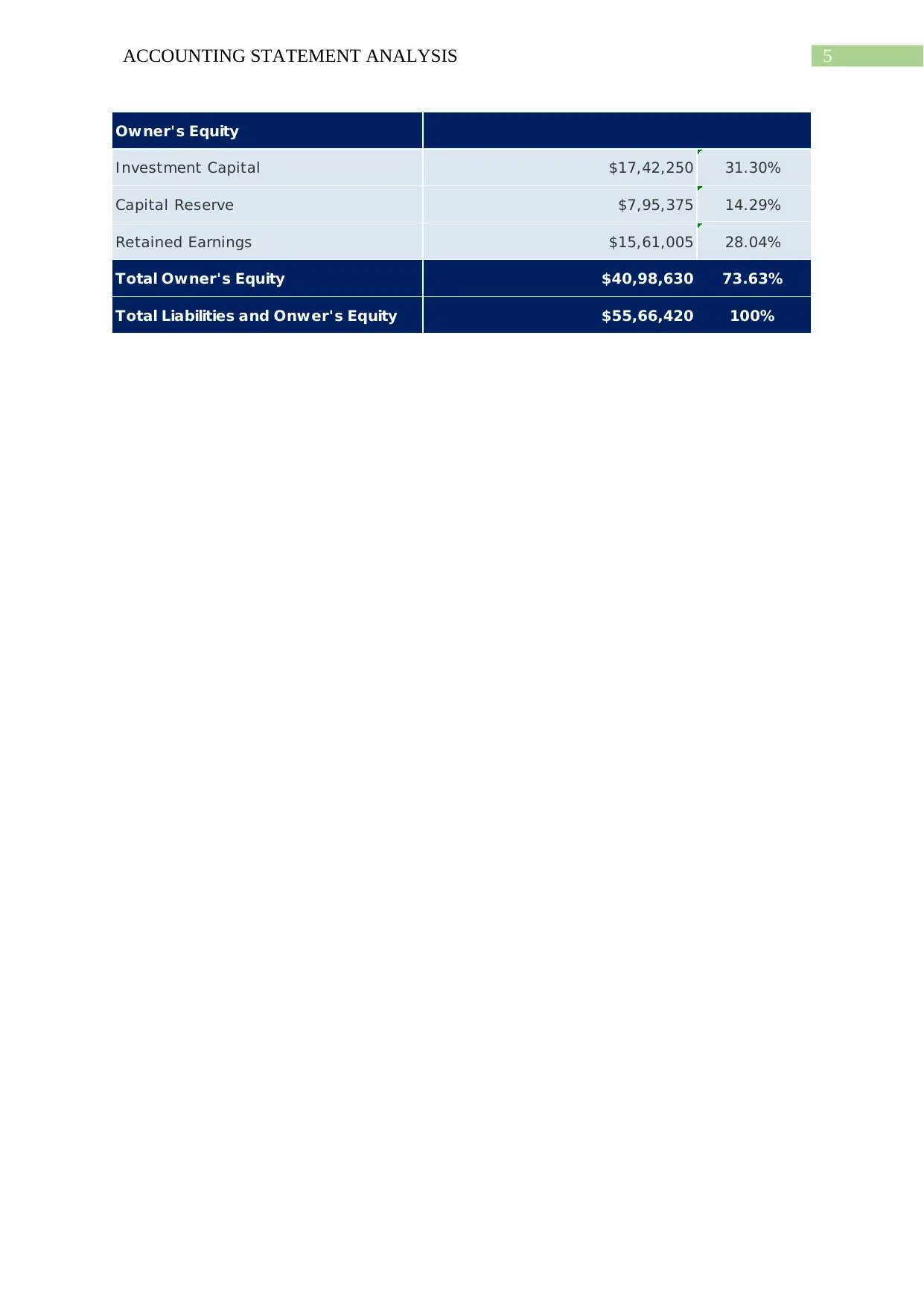
5ACCOUNTING STATEMENT ANALYSIS
Owner's Equity
I nvestment Capital $17,42,250 31.30%
Capital Reserve $7,95,375 14.29%
Retained Earnings $15,61,005 28.04%
Total Owner's Equity $40,98,630 73.63%
Total Liabilities and Onwer's Equity $55,66,420 100%
Owner's Equity
I nvestment Capital $17,42,250 31.30%
Capital Reserve $7,95,375 14.29%
Retained Earnings $15,61,005 28.04%
Total Owner's Equity $40,98,630 73.63%
Total Liabilities and Onwer's Equity $55,66,420 100%
⊘ This is a preview!⊘
Do you want full access?
Subscribe today to unlock all pages.

Trusted by 1+ million students worldwide

6ACCOUNTING STATEMENT ANALYSIS
Calculation of Key Financial Ratios:
Profitability Ratios 2015 I ndustry
Gross Profit Margin 72.41% 81%
Net Profit Margin 19.53% 11%
Return on Assets 22.72% 8%
Return on Equity 30.86% 9%
Efficiency Ratios
I nventory Turnover 1.65 8.60
Number of days I nventory Held 221.08
Accounts Receivable Turnover 0.95
Accounts Receivable Collection Period 382.68 35.00
Liquidity Ratios
Current ratio 1.86 3.20
Quick Ratio 1.46 2.12
Solvency Ratios
Debt to Equity Ratio 35.81%
Debt Ratio 26.37%
Equity Ratio 73.63%
I nterest Coverage 1.67%
Part 2:
Analysis of information included in the general purpose financial statements:
The financial information that are included into the statement of financial position and
profit & loss account is known as general purpose financial statement because it comprises of
Calculation of Key Financial Ratios:
Profitability Ratios 2015 I ndustry
Gross Profit Margin 72.41% 81%
Net Profit Margin 19.53% 11%
Return on Assets 22.72% 8%
Return on Equity 30.86% 9%
Efficiency Ratios
I nventory Turnover 1.65 8.60
Number of days I nventory Held 221.08
Accounts Receivable Turnover 0.95
Accounts Receivable Collection Period 382.68 35.00
Liquidity Ratios
Current ratio 1.86 3.20
Quick Ratio 1.46 2.12
Solvency Ratios
Debt to Equity Ratio 35.81%
Debt Ratio 26.37%
Equity Ratio 73.63%
I nterest Coverage 1.67%
Part 2:
Analysis of information included in the general purpose financial statements:
The financial information that are included into the statement of financial position and
profit & loss account is known as general purpose financial statement because it comprises of
Paraphrase This Document
Need a fresh take? Get an instant paraphrase of this document with our AI Paraphraser
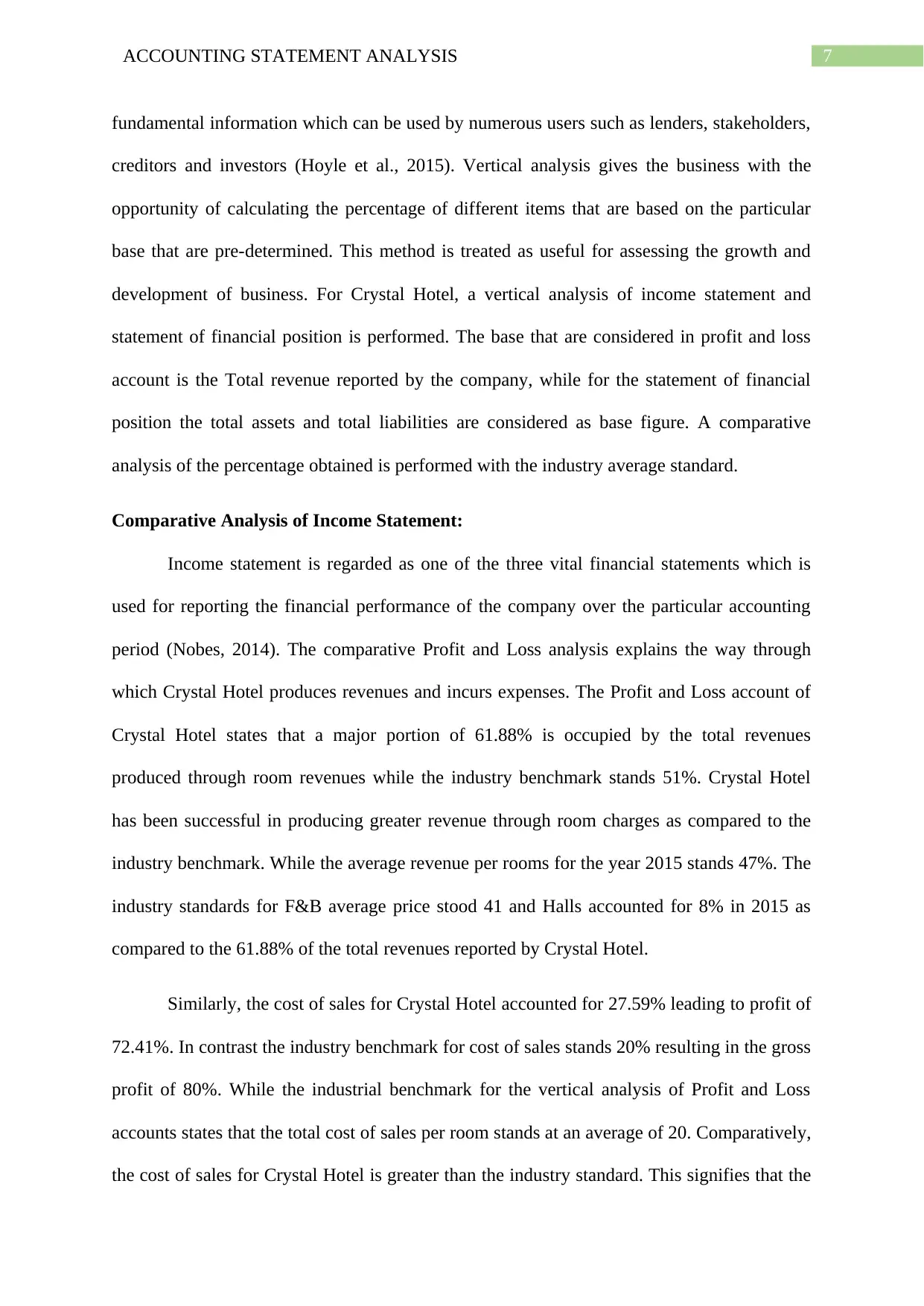
7ACCOUNTING STATEMENT ANALYSIS
fundamental information which can be used by numerous users such as lenders, stakeholders,
creditors and investors (Hoyle et al., 2015). Vertical analysis gives the business with the
opportunity of calculating the percentage of different items that are based on the particular
base that are pre-determined. This method is treated as useful for assessing the growth and
development of business. For Crystal Hotel, a vertical analysis of income statement and
statement of financial position is performed. The base that are considered in profit and loss
account is the Total revenue reported by the company, while for the statement of financial
position the total assets and total liabilities are considered as base figure. A comparative
analysis of the percentage obtained is performed with the industry average standard.
Comparative Analysis of Income Statement:
Income statement is regarded as one of the three vital financial statements which is
used for reporting the financial performance of the company over the particular accounting
period (Nobes, 2014). The comparative Profit and Loss analysis explains the way through
which Crystal Hotel produces revenues and incurs expenses. The Profit and Loss account of
Crystal Hotel states that a major portion of 61.88% is occupied by the total revenues
produced through room revenues while the industry benchmark stands 51%. Crystal Hotel
has been successful in producing greater revenue through room charges as compared to the
industry benchmark. While the average revenue per rooms for the year 2015 stands 47%. The
industry standards for F&B average price stood 41 and Halls accounted for 8% in 2015 as
compared to the 61.88% of the total revenues reported by Crystal Hotel.
Similarly, the cost of sales for Crystal Hotel accounted for 27.59% leading to profit of
72.41%. In contrast the industry benchmark for cost of sales stands 20% resulting in the gross
profit of 80%. While the industrial benchmark for the vertical analysis of Profit and Loss
accounts states that the total cost of sales per room stands at an average of 20. Comparatively,
the cost of sales for Crystal Hotel is greater than the industry standard. This signifies that the
fundamental information which can be used by numerous users such as lenders, stakeholders,
creditors and investors (Hoyle et al., 2015). Vertical analysis gives the business with the
opportunity of calculating the percentage of different items that are based on the particular
base that are pre-determined. This method is treated as useful for assessing the growth and
development of business. For Crystal Hotel, a vertical analysis of income statement and
statement of financial position is performed. The base that are considered in profit and loss
account is the Total revenue reported by the company, while for the statement of financial
position the total assets and total liabilities are considered as base figure. A comparative
analysis of the percentage obtained is performed with the industry average standard.
Comparative Analysis of Income Statement:
Income statement is regarded as one of the three vital financial statements which is
used for reporting the financial performance of the company over the particular accounting
period (Nobes, 2014). The comparative Profit and Loss analysis explains the way through
which Crystal Hotel produces revenues and incurs expenses. The Profit and Loss account of
Crystal Hotel states that a major portion of 61.88% is occupied by the total revenues
produced through room revenues while the industry benchmark stands 51%. Crystal Hotel
has been successful in producing greater revenue through room charges as compared to the
industry benchmark. While the average revenue per rooms for the year 2015 stands 47%. The
industry standards for F&B average price stood 41 and Halls accounted for 8% in 2015 as
compared to the 61.88% of the total revenues reported by Crystal Hotel.
Similarly, the cost of sales for Crystal Hotel accounted for 27.59% leading to profit of
72.41%. In contrast the industry benchmark for cost of sales stands 20% resulting in the gross
profit of 80%. While the industrial benchmark for the vertical analysis of Profit and Loss
accounts states that the total cost of sales per room stands at an average of 20. Comparatively,
the cost of sales for Crystal Hotel is greater than the industry standard. This signifies that the
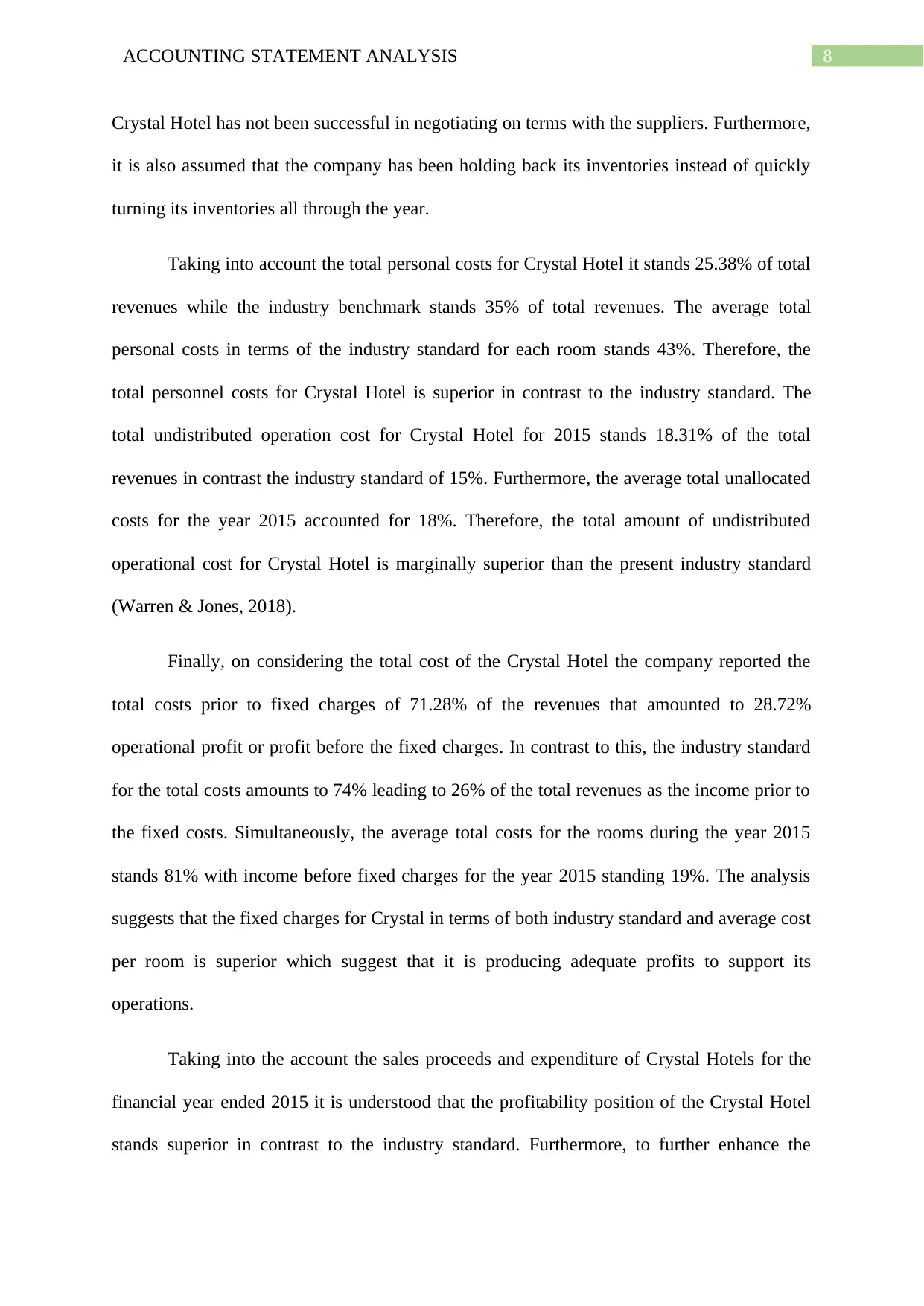
8ACCOUNTING STATEMENT ANALYSIS
Crystal Hotel has not been successful in negotiating on terms with the suppliers. Furthermore,
it is also assumed that the company has been holding back its inventories instead of quickly
turning its inventories all through the year.
Taking into account the total personal costs for Crystal Hotel it stands 25.38% of total
revenues while the industry benchmark stands 35% of total revenues. The average total
personal costs in terms of the industry standard for each room stands 43%. Therefore, the
total personnel costs for Crystal Hotel is superior in contrast to the industry standard. The
total undistributed operation cost for Crystal Hotel for 2015 stands 18.31% of the total
revenues in contrast the industry standard of 15%. Furthermore, the average total unallocated
costs for the year 2015 accounted for 18%. Therefore, the total amount of undistributed
operational cost for Crystal Hotel is marginally superior than the present industry standard
(Warren & Jones, 2018).
Finally, on considering the total cost of the Crystal Hotel the company reported the
total costs prior to fixed charges of 71.28% of the revenues that amounted to 28.72%
operational profit or profit before the fixed charges. In contrast to this, the industry standard
for the total costs amounts to 74% leading to 26% of the total revenues as the income prior to
the fixed costs. Simultaneously, the average total costs for the rooms during the year 2015
stands 81% with income before fixed charges for the year 2015 standing 19%. The analysis
suggests that the fixed charges for Crystal in terms of both industry standard and average cost
per room is superior which suggest that it is producing adequate profits to support its
operations.
Taking into the account the sales proceeds and expenditure of Crystal Hotels for the
financial year ended 2015 it is understood that the profitability position of the Crystal Hotel
stands superior in contrast to the industry standard. Furthermore, to further enhance the
Crystal Hotel has not been successful in negotiating on terms with the suppliers. Furthermore,
it is also assumed that the company has been holding back its inventories instead of quickly
turning its inventories all through the year.
Taking into account the total personal costs for Crystal Hotel it stands 25.38% of total
revenues while the industry benchmark stands 35% of total revenues. The average total
personal costs in terms of the industry standard for each room stands 43%. Therefore, the
total personnel costs for Crystal Hotel is superior in contrast to the industry standard. The
total undistributed operation cost for Crystal Hotel for 2015 stands 18.31% of the total
revenues in contrast the industry standard of 15%. Furthermore, the average total unallocated
costs for the year 2015 accounted for 18%. Therefore, the total amount of undistributed
operational cost for Crystal Hotel is marginally superior than the present industry standard
(Warren & Jones, 2018).
Finally, on considering the total cost of the Crystal Hotel the company reported the
total costs prior to fixed charges of 71.28% of the revenues that amounted to 28.72%
operational profit or profit before the fixed charges. In contrast to this, the industry standard
for the total costs amounts to 74% leading to 26% of the total revenues as the income prior to
the fixed costs. Simultaneously, the average total costs for the rooms during the year 2015
stands 81% with income before fixed charges for the year 2015 standing 19%. The analysis
suggests that the fixed charges for Crystal in terms of both industry standard and average cost
per room is superior which suggest that it is producing adequate profits to support its
operations.
Taking into the account the sales proceeds and expenditure of Crystal Hotels for the
financial year ended 2015 it is understood that the profitability position of the Crystal Hotel
stands superior in contrast to the industry standard. Furthermore, to further enhance the
⊘ This is a preview!⊘
Do you want full access?
Subscribe today to unlock all pages.

Trusted by 1+ million students worldwide
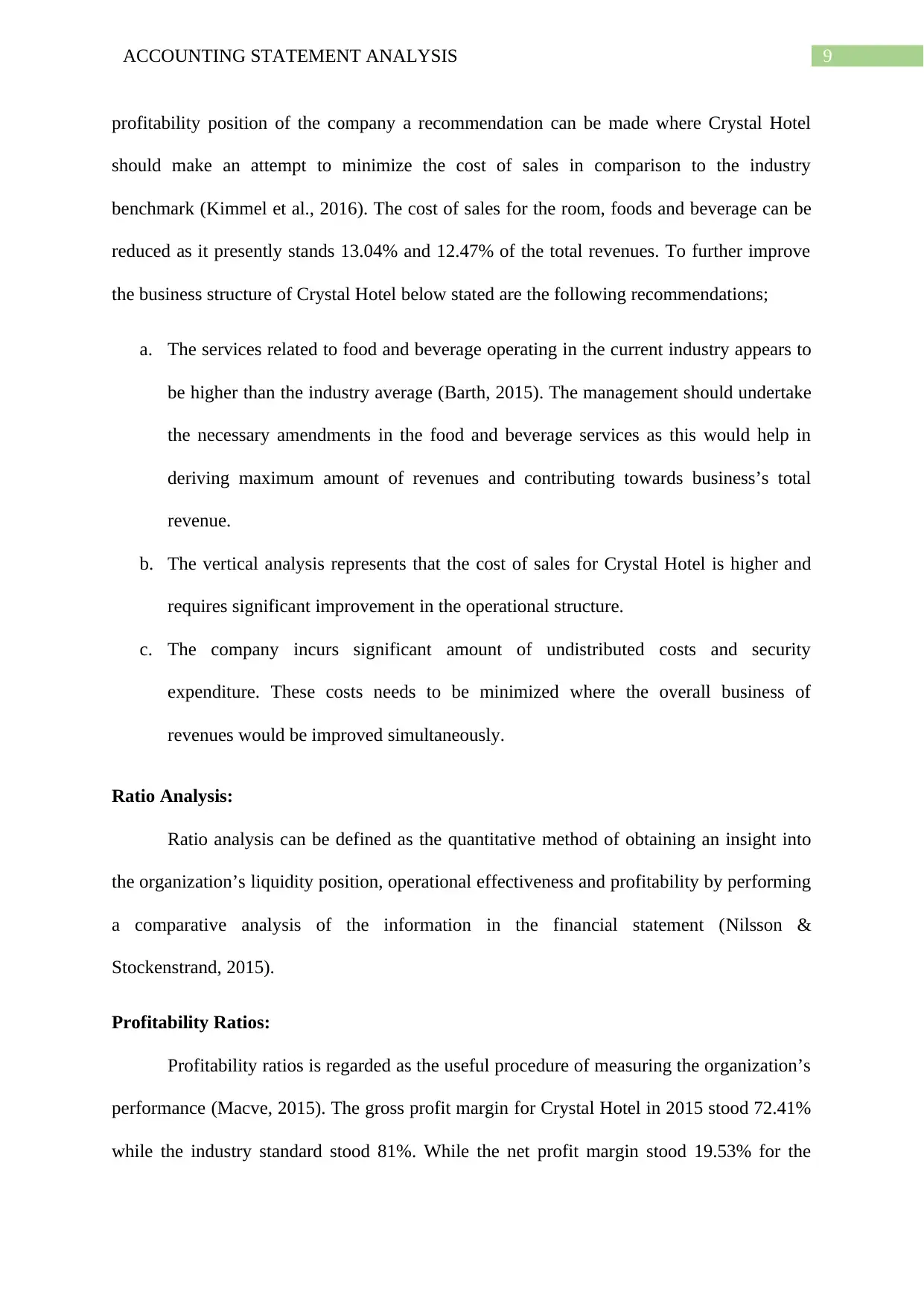
9ACCOUNTING STATEMENT ANALYSIS
profitability position of the company a recommendation can be made where Crystal Hotel
should make an attempt to minimize the cost of sales in comparison to the industry
benchmark (Kimmel et al., 2016). The cost of sales for the room, foods and beverage can be
reduced as it presently stands 13.04% and 12.47% of the total revenues. To further improve
the business structure of Crystal Hotel below stated are the following recommendations;
a. The services related to food and beverage operating in the current industry appears to
be higher than the industry average (Barth, 2015). The management should undertake
the necessary amendments in the food and beverage services as this would help in
deriving maximum amount of revenues and contributing towards business’s total
revenue.
b. The vertical analysis represents that the cost of sales for Crystal Hotel is higher and
requires significant improvement in the operational structure.
c. The company incurs significant amount of undistributed costs and security
expenditure. These costs needs to be minimized where the overall business of
revenues would be improved simultaneously.
Ratio Analysis:
Ratio analysis can be defined as the quantitative method of obtaining an insight into
the organization’s liquidity position, operational effectiveness and profitability by performing
a comparative analysis of the information in the financial statement (Nilsson &
Stockenstrand, 2015).
Profitability Ratios:
Profitability ratios is regarded as the useful procedure of measuring the organization’s
performance (Macve, 2015). The gross profit margin for Crystal Hotel in 2015 stood 72.41%
while the industry standard stood 81%. While the net profit margin stood 19.53% for the
profitability position of the company a recommendation can be made where Crystal Hotel
should make an attempt to minimize the cost of sales in comparison to the industry
benchmark (Kimmel et al., 2016). The cost of sales for the room, foods and beverage can be
reduced as it presently stands 13.04% and 12.47% of the total revenues. To further improve
the business structure of Crystal Hotel below stated are the following recommendations;
a. The services related to food and beverage operating in the current industry appears to
be higher than the industry average (Barth, 2015). The management should undertake
the necessary amendments in the food and beverage services as this would help in
deriving maximum amount of revenues and contributing towards business’s total
revenue.
b. The vertical analysis represents that the cost of sales for Crystal Hotel is higher and
requires significant improvement in the operational structure.
c. The company incurs significant amount of undistributed costs and security
expenditure. These costs needs to be minimized where the overall business of
revenues would be improved simultaneously.
Ratio Analysis:
Ratio analysis can be defined as the quantitative method of obtaining an insight into
the organization’s liquidity position, operational effectiveness and profitability by performing
a comparative analysis of the information in the financial statement (Nilsson &
Stockenstrand, 2015).
Profitability Ratios:
Profitability ratios is regarded as the useful procedure of measuring the organization’s
performance (Macve, 2015). The gross profit margin for Crystal Hotel in 2015 stood 72.41%
while the industry standard stood 81%. While the net profit margin stood 19.53% for the
Paraphrase This Document
Need a fresh take? Get an instant paraphrase of this document with our AI Paraphraser
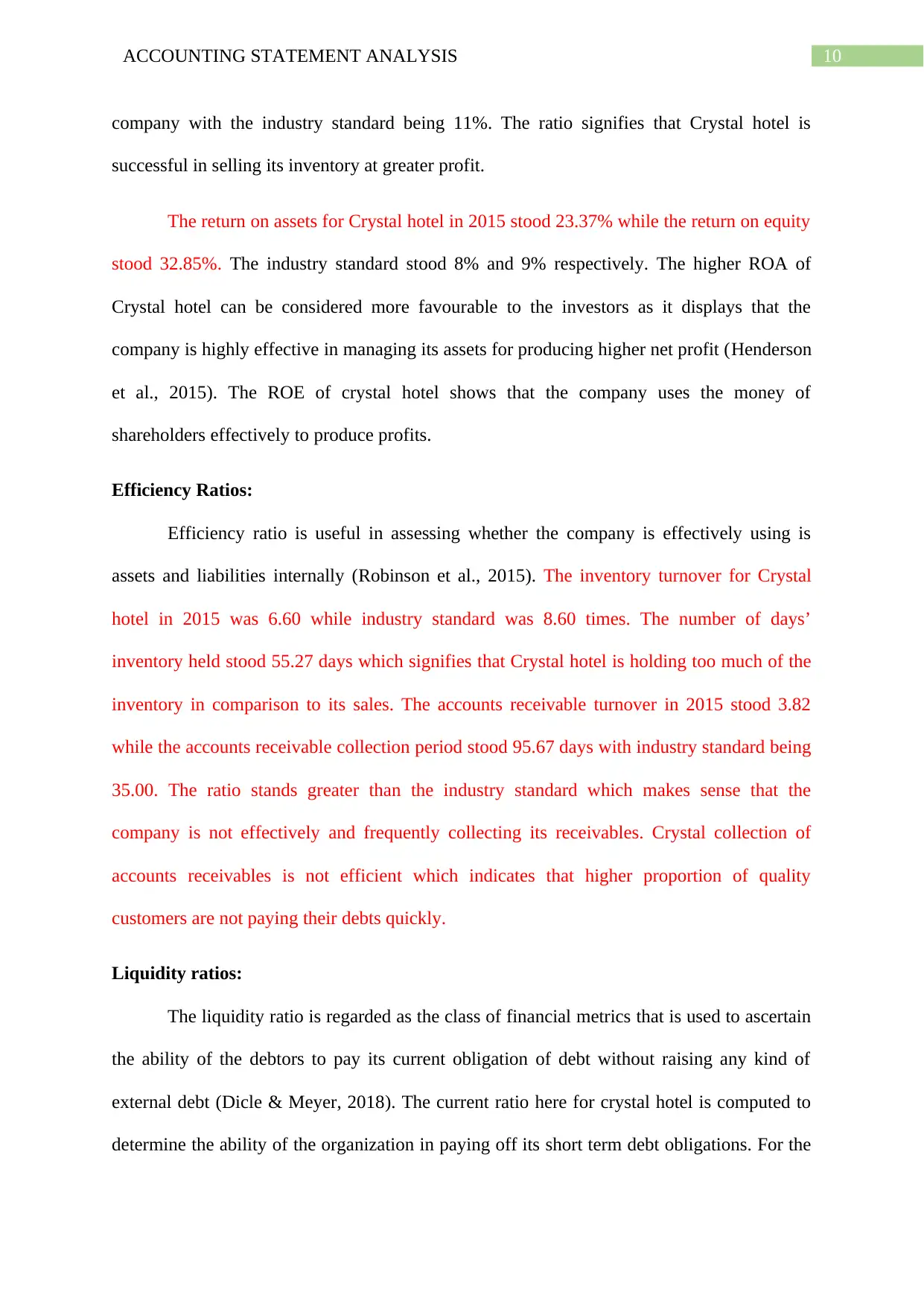
10ACCOUNTING STATEMENT ANALYSIS
company with the industry standard being 11%. The ratio signifies that Crystal hotel is
successful in selling its inventory at greater profit.
The return on assets for Crystal hotel in 2015 stood 23.37% while the return on equity
stood 32.85%. The industry standard stood 8% and 9% respectively. The higher ROA of
Crystal hotel can be considered more favourable to the investors as it displays that the
company is highly effective in managing its assets for producing higher net profit (Henderson
et al., 2015). The ROE of crystal hotel shows that the company uses the money of
shareholders effectively to produce profits.
Efficiency Ratios:
Efficiency ratio is useful in assessing whether the company is effectively using is
assets and liabilities internally (Robinson et al., 2015). The inventory turnover for Crystal
hotel in 2015 was 6.60 while industry standard was 8.60 times. The number of days’
inventory held stood 55.27 days which signifies that Crystal hotel is holding too much of the
inventory in comparison to its sales. The accounts receivable turnover in 2015 stood 3.82
while the accounts receivable collection period stood 95.67 days with industry standard being
35.00. The ratio stands greater than the industry standard which makes sense that the
company is not effectively and frequently collecting its receivables. Crystal collection of
accounts receivables is not efficient which indicates that higher proportion of quality
customers are not paying their debts quickly.
Liquidity ratios:
The liquidity ratio is regarded as the class of financial metrics that is used to ascertain
the ability of the debtors to pay its current obligation of debt without raising any kind of
external debt (Dicle & Meyer, 2018). The current ratio here for crystal hotel is computed to
determine the ability of the organization in paying off its short term debt obligations. For the
company with the industry standard being 11%. The ratio signifies that Crystal hotel is
successful in selling its inventory at greater profit.
The return on assets for Crystal hotel in 2015 stood 23.37% while the return on equity
stood 32.85%. The industry standard stood 8% and 9% respectively. The higher ROA of
Crystal hotel can be considered more favourable to the investors as it displays that the
company is highly effective in managing its assets for producing higher net profit (Henderson
et al., 2015). The ROE of crystal hotel shows that the company uses the money of
shareholders effectively to produce profits.
Efficiency Ratios:
Efficiency ratio is useful in assessing whether the company is effectively using is
assets and liabilities internally (Robinson et al., 2015). The inventory turnover for Crystal
hotel in 2015 was 6.60 while industry standard was 8.60 times. The number of days’
inventory held stood 55.27 days which signifies that Crystal hotel is holding too much of the
inventory in comparison to its sales. The accounts receivable turnover in 2015 stood 3.82
while the accounts receivable collection period stood 95.67 days with industry standard being
35.00. The ratio stands greater than the industry standard which makes sense that the
company is not effectively and frequently collecting its receivables. Crystal collection of
accounts receivables is not efficient which indicates that higher proportion of quality
customers are not paying their debts quickly.
Liquidity ratios:
The liquidity ratio is regarded as the class of financial metrics that is used to ascertain
the ability of the debtors to pay its current obligation of debt without raising any kind of
external debt (Dicle & Meyer, 2018). The current ratio here for crystal hotel is computed to
determine the ability of the organization in paying off its short term debt obligations. For the
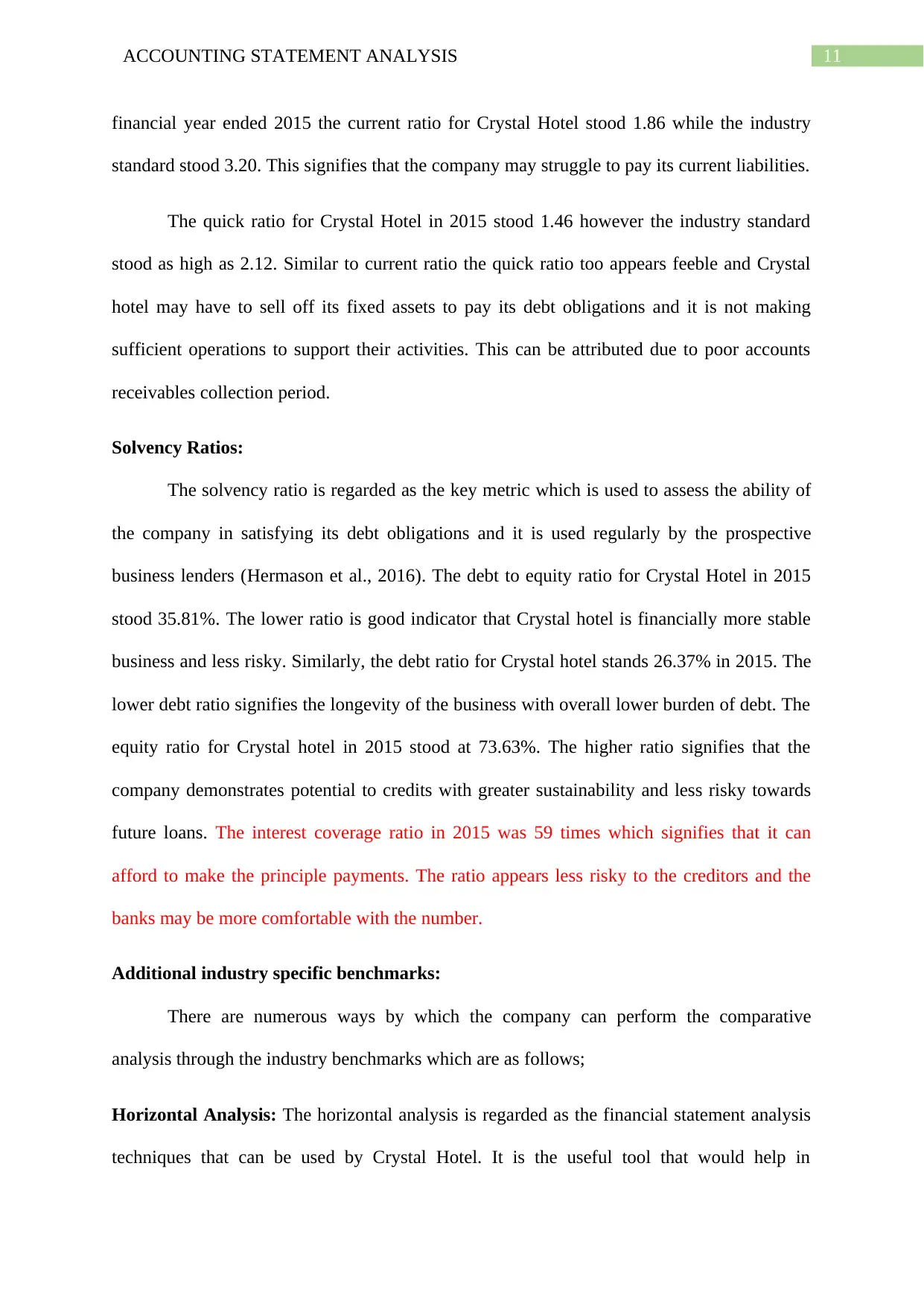
11ACCOUNTING STATEMENT ANALYSIS
financial year ended 2015 the current ratio for Crystal Hotel stood 1.86 while the industry
standard stood 3.20. This signifies that the company may struggle to pay its current liabilities.
The quick ratio for Crystal Hotel in 2015 stood 1.46 however the industry standard
stood as high as 2.12. Similar to current ratio the quick ratio too appears feeble and Crystal
hotel may have to sell off its fixed assets to pay its debt obligations and it is not making
sufficient operations to support their activities. This can be attributed due to poor accounts
receivables collection period.
Solvency Ratios:
The solvency ratio is regarded as the key metric which is used to assess the ability of
the company in satisfying its debt obligations and it is used regularly by the prospective
business lenders (Hermason et al., 2016). The debt to equity ratio for Crystal Hotel in 2015
stood 35.81%. The lower ratio is good indicator that Crystal hotel is financially more stable
business and less risky. Similarly, the debt ratio for Crystal hotel stands 26.37% in 2015. The
lower debt ratio signifies the longevity of the business with overall lower burden of debt. The
equity ratio for Crystal hotel in 2015 stood at 73.63%. The higher ratio signifies that the
company demonstrates potential to credits with greater sustainability and less risky towards
future loans. The interest coverage ratio in 2015 was 59 times which signifies that it can
afford to make the principle payments. The ratio appears less risky to the creditors and the
banks may be more comfortable with the number.
Additional industry specific benchmarks:
There are numerous ways by which the company can perform the comparative
analysis through the industry benchmarks which are as follows;
Horizontal Analysis: The horizontal analysis is regarded as the financial statement analysis
techniques that can be used by Crystal Hotel. It is the useful tool that would help in
financial year ended 2015 the current ratio for Crystal Hotel stood 1.86 while the industry
standard stood 3.20. This signifies that the company may struggle to pay its current liabilities.
The quick ratio for Crystal Hotel in 2015 stood 1.46 however the industry standard
stood as high as 2.12. Similar to current ratio the quick ratio too appears feeble and Crystal
hotel may have to sell off its fixed assets to pay its debt obligations and it is not making
sufficient operations to support their activities. This can be attributed due to poor accounts
receivables collection period.
Solvency Ratios:
The solvency ratio is regarded as the key metric which is used to assess the ability of
the company in satisfying its debt obligations and it is used regularly by the prospective
business lenders (Hermason et al., 2016). The debt to equity ratio for Crystal Hotel in 2015
stood 35.81%. The lower ratio is good indicator that Crystal hotel is financially more stable
business and less risky. Similarly, the debt ratio for Crystal hotel stands 26.37% in 2015. The
lower debt ratio signifies the longevity of the business with overall lower burden of debt. The
equity ratio for Crystal hotel in 2015 stood at 73.63%. The higher ratio signifies that the
company demonstrates potential to credits with greater sustainability and less risky towards
future loans. The interest coverage ratio in 2015 was 59 times which signifies that it can
afford to make the principle payments. The ratio appears less risky to the creditors and the
banks may be more comfortable with the number.
Additional industry specific benchmarks:
There are numerous ways by which the company can perform the comparative
analysis through the industry benchmarks which are as follows;
Horizontal Analysis: The horizontal analysis is regarded as the financial statement analysis
techniques that can be used by Crystal Hotel. It is the useful tool that would help in
⊘ This is a preview!⊘
Do you want full access?
Subscribe today to unlock all pages.

Trusted by 1+ million students worldwide
1 out of 15
Related Documents
Your All-in-One AI-Powered Toolkit for Academic Success.
+13062052269
info@desklib.com
Available 24*7 on WhatsApp / Email
![[object Object]](/_next/static/media/star-bottom.7253800d.svg)
Unlock your academic potential
Copyright © 2020–2025 A2Z Services. All Rights Reserved. Developed and managed by ZUCOL.




